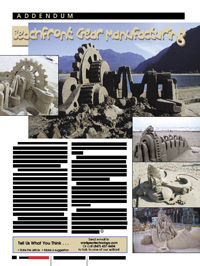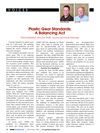Plastic Gear Standards: A Balancing Act

David Sheridan and Zan Smith, Ticona Technical Polymers
Creating standards for plastic gears calls for a deft touch. The challenge is to set uniform guidelines, yet avoid limiting the creative solutions plastic offers gear designers.
Few standards and guides exist for plastic gears. This is not surprising given that they have only been used for about 60 years compared to hundreds of years for metal gearing. Another reason lies in plastic’s great variability. This class of materials encompasses diverse resin families, each offering many choices in the nature of the polymer and the ability to enhance performance with fibers, fillers and functional additives. In addition, a polymer’s mechanical properties can shift significantly with temperature and other environmental factors within the typical operating range of a gear set.
At this time, just two American Gear Manufacturers Association (AGMA) plastic gear standards exist: ANSI/AGMA 1006-A97, Tooth Proportions for Plastic Gears, and its metric version ANSI/AGMA 1106-A97. They were developed in 1997 and set standardized tooth profiles for spur and helical gears. Some other national bodies have also created plastic gear standards. British standard BS 6168 looks at non-metallic spur gears and has many similarities with the German document VDI 2545. There may be plastic gear standards from other countries that are unknown to the authors.
In recent years, AGMA has published two information sheets as plastic gear design guides. One, AGMA 920-A01, Materials for Plastic Gears, offers help in selecting poly- mers for injection-molded and cut gears based on understanding material behavior and molding considerations for dimensions and gear-related properties. The other, AGMA 909-A06, Specifications for Molded Plastic Gears, applies to injection-molded external and internal spur and helical gears. AGMA also has documents underway on test methods and inspection for plastic gears.
Need for New Standards
Among the many possible plastic gear standards that remain to be developed, two would be especially useful: one for load ratings and the other for quality measurement.





